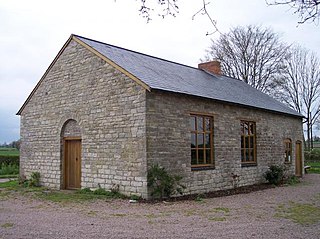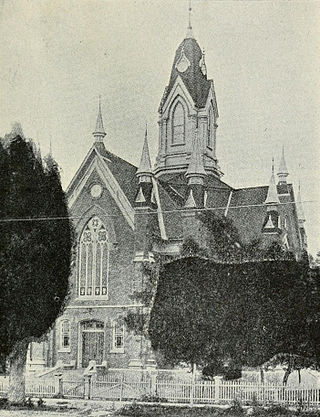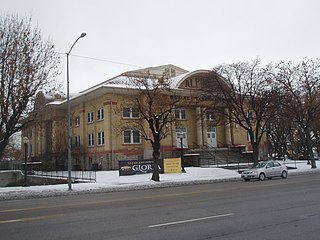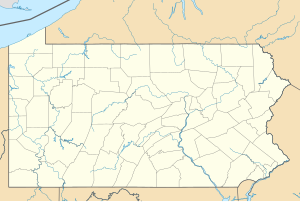
The Salt Lake City Council Hall is currently home to offices of the Utah Office of Tourism and the Utah Film Commission and is located on Capitol Hill in Salt Lake City, Utah. Built in 1864-66, the building is historically important as the Old Salt Lake City Hall or just Old City Hall from 1866 to 1894. It was designated a National Historic Landmark in 1975, as an emblem of the conflicts between the governments of the Utah Territory and the United States in the 19th century.

The Chicago Illinois Temple is the thirty-fifth temple of the Church of Jesus Christ of Latter-day Saints. It is the second of three church temples that have been built in Illinois.
The term Jack Mormon is a slang term originating in nineteenth-century America. It was originally used to describe a person who was not a baptized member of the Church of Jesus Christ of Latter Day Saints but who was friendly to church members and Mormonism, sympathized with them, and/or took an active interest in their belief system. Sometime in the early- to mid-twentieth century, however, the term began to refer to an individual deemed by adherents of the Church of Jesus Christ of Latter-day Saints to be an inactive or lapsed member of the LDS Church who, despite their personal religious viewpoint, maintained good relations with and positive feelings toward the church.

Winter Quarters was an encampment formed by approximately 2,500 members of the Church of Jesus Christ of Latter-day Saints as they waited during the winter of 1846–47 for better conditions for their trek westward. It followed a preliminary tent settlement some 3½ miles west at Cutler's Park. Members of the LDS faith built more than 800 cabins at the Winter Quarters settlement. Located in present-day North Omaha overlooking the Missouri River, the settlement remained populated until 1848.

The Vernal Utah Temple is the fifty-first temple of the Church of Jesus Christ of Latter-day Saints. The temple is located in Vernal and is the tenth LDS temple built in the state of Utah.

The Joseph Smith Memorial Building, originally called the Hotel Utah, is a social center located on the corner of Main Street and South Temple in Salt Lake City. It is named in honor of Joseph Smith, the founder of the Latter Day Saint movement. It houses several restaurants and also functions as a venue for events. Several levels of the building also serve as administrative offices for the Church of Jesus Christ of Latter-day Saints departments such as FamilySearch. On January 3, 1978, it was added to the National Register of Historic Places as the Hotel Utah.

Thomas Leiper Kane was an American attorney, abolitionist, philanthropist, and military officer who was influential in the western migration of the Latter-day Saint movement and served as a Union Army colonel and general of volunteers in the American Civil War. He received a brevet promotion to major general for gallantry at the Battle of Gettysburg.

The Gadfield Elm Chapel near the village of Pendock in Worcestershire, England, is the oldest extant chapel of the Church of Jesus Christ of Latter-day Saints.

The Kansas City Missouri Temple is the 137th operating temple of the Church of Jesus Christ of Latter-day Saints. It is the first to be built in the Greater Kansas City area. Previous attempts at building a temple in the area failed in Independence in 1833 and Far West in 1838, after church founder Joseph Smith had selected and dedicated locations for their construction. A temple was completed in Independence in 1994 by the Community of Christ, which is not affiliated with The Church of Jesus Christ of Latter-day Saints.

The Philadelphia Pennsylvania Temple is a temple of the Church of Jesus Christ of Latter-day Saints in the Logan Square neighborhood of Philadelphia. Completed in 2016, the intent to construct the temple was announced on October 4, 2008, during the church's 178th Semiannual General Conference by LDS Church president Thomas S. Monson. The temple is the church's first in the state of Pennsylvania, and the first temple between Washington, D.C., and New York City.

Built in 1909, the Murray LDS Second Ward Meetinghouse is a historic building in Murray, Utah, United States. It was listed on the National Register of Historic Places in 2001. The building is significant for its association with the history and development of Murray between 1909 and 1950.

The Priesthood Restoration Site, formally known as the Aaronic Priesthood Restoration Site, is a historic site located in Oakland Township, Susquehanna County, Pennsylvania, United States. Due to its historical significance to Mormonism, the site is owned and operated by the Church of Jesus Christ of Latter-day Saints. The site comprises property once owned, and lived on, by Joseph Smith and is the spot where Latter Day Saints believe the resurrected John the Baptist conferred the Aaronic priesthood upon Smith and Oliver Cowdery in 1829. In September 2015, the church dedicated the site, which includes a visitors' center and meetinghouse, monuments, and the reconstructed homes of Smith and the Hale family.

The Summit Stake Tabernacle or "Coalville Tabernacle" was a meetinghouse of the Church of Jesus Christ of Latter-day Saints located in Coalville, Summit County, Utah.

The Alpine Stake Tabernacle or Alpine Tabernacle, located at 110 East Main Street (US-89) in American Fork, Utah, United States, functions as a meeting place for large gatherings of members of the Church of Jesus Christ of Latter-day Saints in northern Utah County for worship services. The building is part of the American Fork Historic District listed on the National Register of Historic Places.

The Church of Jesus Christ of Latter-day Saints in England refers to the Church of Jesus Christ of Latter-day Saints and its members in England. England has five missions, and both temples in the United Kingdom. With 145,385 members in 2011, England had more LDS Church members than any other country in Europe.

The following outline is provided as an overview of and a topical guide to the Church of Jesus Christ of Latter-day Saints.

The Kanesville Tabernacle was a large, hastily constructed log building in Council Bluffs, Iowa that was created specifically for the event of the reorganization of the First Presidency of the Church of Jesus Christ of Latter-day Saints in late 1847.

Tithing buildings of The Church of Jesus Christ of Latter-day Saints are storehouses related to tithing by members of the Church of Jesus Christ of Latter-day Saints.




















